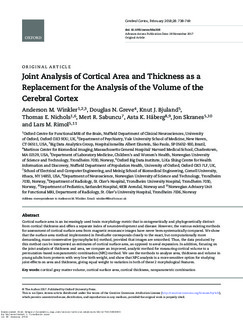| dc.contributor.author | Winkler, Anderson M. | |
| dc.contributor.author | Greve, Doug | |
| dc.contributor.author | Bjuland, Knut Jørgen | |
| dc.contributor.author | Nichols, Tom | |
| dc.contributor.author | Sabuncu, Mert | |
| dc.contributor.author | Håberg, Asta | |
| dc.contributor.author | Skranes, Jon Sverre | |
| dc.contributor.author | Rimol, Lars Morten | |
| dc.date.accessioned | 2018-01-30T12:10:50Z | |
| dc.date.available | 2018-01-30T12:10:50Z | |
| dc.date.created | 2017-12-30T10:50:26Z | |
| dc.date.issued | 2017 | |
| dc.identifier.citation | Cerebral Cortex. 2017, Nov (28), 1-12. | nb_NO |
| dc.identifier.issn | 1047-3211 | |
| dc.identifier.uri | http://hdl.handle.net/11250/2480643 | |
| dc.description.abstract | Cortical surface area is an increasingly used brain morphology metric that is ontogenetically and phylogenetically distinct from cortical thickness and offers a separate index of neurodevelopment and disease. However, the various existing methods for assessment of cortical surface area from magnetic resonance images have never been systematically compared. We show that the surface area method implemented in FreeSurfer corresponds closely to the exact, but computationally more demanding, mass-conservative (pycnophylactic) method, provided that images are smoothed. Thus, the data produced by this method can be interpreted as estimates of cortical surface area, as opposed to areal expansion. In addition, focusing on the joint analysis of thickness and area, we compare an improved, analytic method for measuring cortical volume to a permutation-based nonparametric combination (NPC) method. We use the methods to analyze area, thickness and volume in young adults born preterm with very low birth weight, and show that NPC analysis is a more sensitive option for studying joint effects on area and thickness, giving equal weight to variation in both of these 2 morphological features. | nb_NO |
| dc.language.iso | eng | nb_NO |
| dc.publisher | Oxford University Press (OUP) | nb_NO |
| dc.rights | Navngivelse 4.0 Internasjonal | * |
| dc.rights.uri | http://creativecommons.org/licenses/by/4.0/deed.no | * |
| dc.title | Joint Analysis of Cortical Area and Thickness as a Replacement for the Analysis of the Volume of the Cerebral Cortex | nb_NO |
| dc.type | Journal article | nb_NO |
| dc.type | Peer reviewed | nb_NO |
| dc.description.version | publishedVersion | nb_NO |
| dc.source.pagenumber | 738–749 | nb_NO |
| dc.source.volume | 28 | nb_NO |
| dc.source.journal | Cerebral Cortex | nb_NO |
| dc.source.issue | 2 | nb_NO |
| dc.identifier.doi | 10.1093/cercor/bhx308 | |
| dc.identifier.cristin | 1532964 | |
| dc.description.localcode | © The Author 2017. Published by Oxford University Press. This is an Open Access article distributed under the terms of the Creative Commons Attribution License (http://creativecommons.org/licenses/by/4.0/) | nb_NO |
| cristin.unitcode | 194,65,30,0 | |
| cristin.unitcode | 194,65,15,0 | |
| cristin.unitcode | 194,65,25,0 | |
| cristin.unitname | Institutt for nevromedisin og bevegelsesvitenskap | |
| cristin.unitname | Institutt for klinisk og molekylær medisin | |
| cristin.unitname | Institutt for sirkulasjon og bildediagnostikk | |
| cristin.ispublished | true | |
| cristin.fulltext | original | |
| cristin.qualitycode | 2 | |

